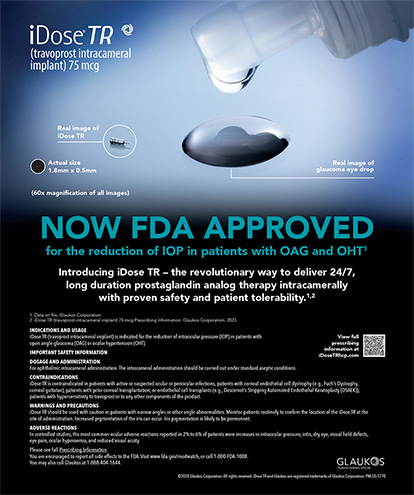In an ongoing effort to provide dry eye disease (DED) sufferers with a long-lasting, effective artificial tear option, researchers recently evaluated the efficacy of a novel lubricant, Retaine ophthalmic emulsion (OcuSoft), in subjects with moderate to severe DED.1 The agent is a proprietary cationic oil-in-water nanoemulsion technology with novel bioadhesive properties, marketed outside the United States as Cationorm (Santen).
In the phase 4, single-center study, 42 subjects received one to two drops of the emulsion twice daily for 2 weeks. At the close of the study, subjects demonstrated significant improvements in corneal fluorescein staining. At the second visit, subjects had significantly less staining in the superior (P = .002), central (P = .017), and corneal sum regions (P = .011), in addition to all regions combined (ie, the score of both corneal and conjunctival fluorescein staining) (P = .038). Because Ousler and others have shown a link between central corneal staining and visual function, this reduction is of particular clinical relevance. To that point, study subjects experienced a 41% longer time at BCVA (time to 1 line of loss of BCVA) on the second visit compared to the first (P = .0697), demonstrating a correlation between reduced central corneal staining and improved visual function.
Other sign assessments included the measurement of corneal exposure. Using a video-based technology (OPI 2.0; Ora), study subjects were observed to have a 40% reduction in corneal exposure on the second visit between the predose and the postdose time points (P = .026), indicating an immediate-onset improvement in tear film stability.
An artificial tear that has a positive response from the patient is of the utmost importance in this symptom-driven disease. In this study, subjects noted symptomatic improvements in their ocular discomfort (P = .0017), dryness (P < .001), grittiness (P = .0217), and all symptoms combined (P < .001). Additionally, subjects reported a significant improvement in their ocular discomfort at night when they worked on a computer (P = .044), and while reading, watching television, and driving. Finally, the study drug was well tolerated; when prompted to select three terms that best described the drops, 45% of the subjects selected only positive descriptors (comfortable, cool, refreshing, smooth, soothing, thick, filmy), and only 2% selected only negative descriptors (sticky, burning, itchy, fuzzy, stinging, irritating, gritty).
After just 2 weeks of dosing, study subjects noticed dramatic improvements in their symptoms and quality of life, while researchers were able to tangibly measure ocular surface improvements. The therapeutic effect of Retaine on all facets of DED indicates that it is an effective option for patients suffering from the disease.
1. Ousler III G, Devries DK, Karpecki PM, Ciolino JB. An evaluation of Retaine ophthalmic emulsion in the management of tear film stability and ocular surface staining in patients diagnosed with dry eye. Clin Ophthalmol. 2015;2015(9):235-243.


